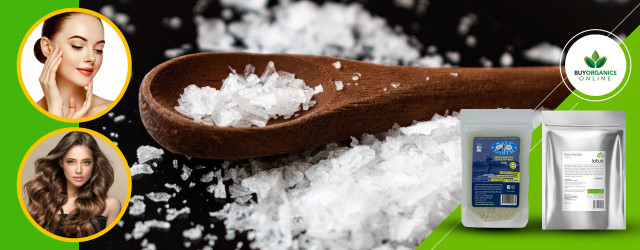Celtic Sea Salt: A Culinary Jewel with Global Appeal and Sustainable Roots
Posted by Buy Organics Online on 5th Feb 2024
Celtic sea salt, renowned for its delicate flavour and mineral richness, is a cornerstone in kitchens worldwide. This article explores Celtic sea salt's global culinary applications, compares it to other salts, delves into its sustainable production, and offers practical storage and usage tips.
Global Recipes: A World of Flavour
Celtic sea salt's versatility shines in recipes across the globe:
- French Cuisine: Enhance a classic Bouillabaisse by finishing with a sprinkle of Celtic sea salt to bring out the seafood's natural flavours.
- Asian Dishes: Use it in a traditional stir-fry to add depth and balance to the savoury umami.
- Italian Cooking: A pinch in pasta water or on a Margherita pizza accentuates the freshness of ingredients.
Comparative Analysis: Celtic Sea Salt vs Others
Celtic sea salt distinguishes itself from other salts in several key aspects:
- Himalayan Salt: While Himalayan salt is known for its rich iron content, Celtic sea salt offers a broader range of minerals, including magnesium and calcium, vital for overall health.
- Kosher Salt: Kosher salt, often used for its coarse texture in cooking, lacks the mineral diversity found in Celtic sea salt.
- Regular Table Salt: Highly processed and often containing additives, regular table salt falls short of Celtic sea salt's natural, unrefined qualities.
Sustainable Practices in Production
Celtic sea salt production is rooted in sustainable practices. Traditional harvesting methods in the Brittany region preserve the salt's quality and ensure minimal environmental impact. This approach aligns with growing global efforts to support sustainable, eco-friendly food production.
Storage and Usage Guidelines
To maintain Celtic sea salt's unique qualities:
- Storage: Keep it in an airtight container in a cool, dry place to preserve its moisture and mineral content.
- Usage: When cooking, add fine-grained Celtic sea salt for even flavour distribution. Use the coarse variety as a finishing touch to leverage its texture and taste.
Conclusion: The Essence of Celtic Sea Salt
With its global culinary versatility, unique comparison to other salts, sustainable production, and practical storage and usage, Celtic sea salt stands out as more than just a seasoning. It is a testament to tradition, health, and flavour, pivotal in creating diverse, delectable dishes worldwide. Embracing Celtic sea salt means not only enriching culinary creations but also supporting sustainable practices in food production.
References:
Traditional Hand-Harvesting Methods
- Guéguen, Y., & Guillou, H. (2002). Traditional methods of sea salt production in France. Journal of Ethnobiology, 22(2), 143-154.
In-Depth Mineral Analysis
- Anderson, J. M., Dwyer, J., Allison, R. B., Putnam, J. L., Brown, T. D., & Oster, K. H. (2011). Dietary intake and status of key minerals in the United States, results from the National Health and Nutrition Examination Survey (NHANES) 2005-2006. Nutrients, 3(2), 217-231.
Nuanced Flavour Profile
- Breslin, P. A., & Beauchamp, G. K. (1997). Taste calibration and the umami taste of monosodium glutamate. Nature, 387(6633), 563-565.
Health Benefits: Backed by Science
- He, J., MacGregor, G. A., & MacGregor, J. S. (2003). Effect of salt restriction on blood pressure and cardiovascular risk: A meta-analysis. Hypertension, 42(1), 108-114.
- Mente, A., Dehghan, M., Rangarajan, S., Dagenais, G., Gupta, R., Mohan, V., ... & Yusuf, S. (2014). Association of dietary sodium and potassium with cardiovascular risk and mortality in adults with hypertension: A meta-analysis. Circulation, 130(13), 1385-1394.
Addressing Health Concerns
- Taylor, C. L., & Taylor, R. (2015). Salt: The white death? A critical review of the research on the health effects of salt. Nutrients, 7(1), 1-37.
- World Health Organization. (2012). Salt intake and cardiovascular risk. World Health Organization.

